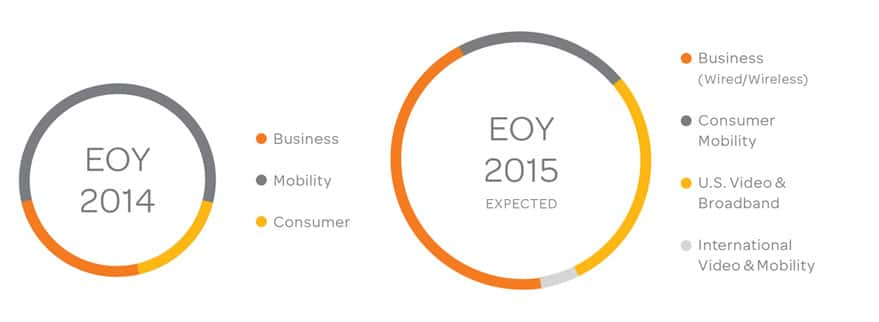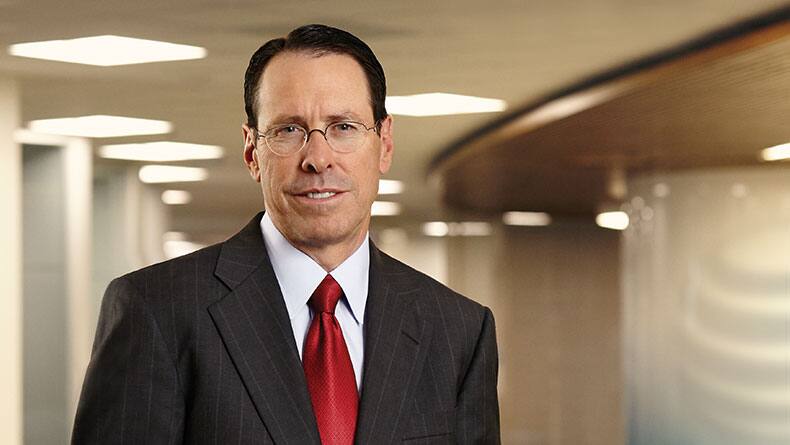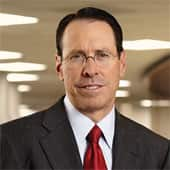Randall Stephenson
Chairman,
Chief Executive Officer
and President
To our investors,
Fast, secure and mobile connectivity to everything on the Internet – everywhere, at every moment and on every device – is what drives us at AT&T. It is why we build wireless and wired networks engineered to handle massive volumes. And the more capacity and speed we build into our networks, the more intensively and creatively our customers use them. Today, our customers are taking advantage of these networks, streaming video to all of their devices at unprecedented levels. In fact, today more than 50 percent of our network traffic is video.
The byproduct of our investments in these advanced networks has been rapid innovation across the entire technology ecosystem – software services, cloud computing, mobile apps and connected devices. All of this is changing how people live, how businesses run and how economies grow.
But these investments are also changing AT&T into a vastly different company with unique capabilities serving new markets that will further differentiate us from our competitors. Over the past several years, we have taken several steps to position AT&T for the future, while rewarding you, our shareholders, with solid returns.
A premier network experience
It all begins with delivering a premier network experience. From 2012 to 2014, we substantially completed our VIP network upgrade plan, investing at historic levels. The result is a combination of wireless, wired and – with DIRECTV – satellite networks that handle unmatched volumes of traffic, principally video.
We now cover more than 300 million people in the United States with our LTE mobile service; along the way, we re-engineered our network so that it now delivers the strongest LTE signal in the United States.1 We deployed wired high-speed Internet service to 57 million customer locations. And we now have high-speed fiber connections to more than 1 million U.S. business locations, including those added through VIP. Between now and 2020, we expect the vast majority of wireline customers to transition to our most advanced network technology and, in the process, significantly reduce our operating costs.
Staying ahead of our customers’ growing demand for mobile Internet service, particularly video entertainment, requires access to significant wireless radio spectrum. Over the past year, we made several spectrum investments – highlighted by our Leap Wireless acquisition in 2014 and the $18.2 billion we committed to invest earlier this year in a government auction to acquire a near-nationwide block of high-quality spectrum. Why was this important? Over the last eight years, mobile data traffic on our wireless network increased 100,000 percent – driven by people downloading and sharing videos.
Over the past year, we made several spectrum investments – highlighted by our Leap Wireless acquisition in 2014 and the $18.2 billion we committed to invest earlier this year in a government auction to acquire a near-nationwide block of high-quality spectrum.
Less visible to customers today, but fundamental to how we’ll serve them and stay ahead of the escalating capacity demands created by video, is the work we’re doing to virtualize more and more of our core network functions. This means we’re putting software rather than hardware at the center of our network and IT infrastructure. The advantages of this shift to software are game changing – dramatically lowering our costs, accelerating the rollout of new services and giving greater control to our customers.
Expanding our video business
Earlier, I pointed out that video is driving huge increases in network traffic. That’s no surprise when you consider that customers want their video on every screen, whether it’s traditional pay TV service, video streamed over an Internet connection or video to a mobile device. So, in addition to our network investments, we’ve been assembling the other pieces needed to lead in delivering video when, where and how customers want it.
Our acquisition of DIRECTV, which we expect to complete in the first half of 2015, will make us the world’s largest pay TV provider, giving us nationwide reach in the United States, plus 11 Latin American countries. DIRECTV’s premier TV service significantly improves the economics and expands the geographic reach of our current TV business. The acquisition places us in the best position to provide customers with integrated packages of TV, mobile and high-speed Internet services.
DIRECTV will also provide us with the best content-owner relationships in the industry. These relationships are critical to being able to deliver premium content across multiple screens, particularly mobile devices, to meet consumers’ future video viewing and programming preferences. Getting more content to more screens is also the aim of our Otter Media joint venture with The Chernin Group, which is building new digital video brands and online services.
DIRECTV’s superior quality and profitable nationwide TV service make it economically attractive to significantly expand our high-speed Internet service to a total of 70 million customer locations, because people like to buy TV and Internet service together.
Not only does DIRECTV perfectly complement our existing business, it significantly diversifies our revenue mix and is expected to be accretive within a year after close on a free cash flow per share and adjusted EPS basis.
Expanding our mobile network to Mexico
We believe that the model in the United States, with exploding demand for mobile Internet service and all the associated economic benefits, will be repeated around the world as companies invest in high-speed mobile networks. That belief has us searching for opportunities to invest in wireless outside the U.S. where the regulatory, investment and economic climate is right.
We believe that environment now exists in Mexico. Recent changes in Mexico’s legal and regulatory framework have made it very attractive for a new entrant. We closed our Iusacell acquisition in early 2015 and expect to complete our Nextel Mexico deal by mid-year. Once we do, we’ll move quickly to build a world-class mobile business in a country with a strong economic outlook, a growing middle class and close trade, cultural and geographic ties to the United States.
We’ll be able to offer customers the first-ever North American Mobile Service area – one seamless network that will cover more than 400 million people and businesses in the United States and Mexico. For families and businesses that span the border, AT&T will be the only company with an advanced mobile network – built for video – across both countries.
North American mobile service area
To cover more than 400M people and businesses

A new kind of company
By the end of 2015, once we close our DIRECTV and Nextel Mexico acquisitions, we will be a very different company. Our revenue mix will be much more diversified and our ability to integrate products and services will set us apart from competitors. Our revenue will come from four areas:
- Business services (wireless and wired) will be our largest revenue stream
- U.S. consumer TV and Internet service will be second
- U.S. consumer mobility will be third, comprising about 20 percent of total revenues
- Mexico and Latin American TV and mobility will be our smallest but fastest-growing area
Diversifying our revenues
By the end of 2015, AT&T expects its largest revenue stream will be business (wired and wireless)

We like that mix a lot. Not only will a more diversified mix of services, customers and geographies make us much less dependent on the U.S. consumer wireless market, we’ll be a new breed of company – one that will redefine what a communications company is and what it does.
We will be a company with the ability to deliver video to any device. We will be able to deliver integrated capabilities across a diversified base of services, customers, geographies and technology platforms that are mobile, fast and highly secure. We will have a path to profitable TV growth. And we will have a nice set of growing Latin American businesses positioned well in video and the mobile Internet.
Regulation that looks forward, not back
The historic investments that catapulted America to global leadership in the mobile Internet and high-tech innovation were the direct result of deliberate and wise government policy. Since the Clinton administration, policymakers have agreed, on a bipartisan basis, that light-touch regulation was the proper approach for the Internet. This decision helped unleash nearly two decades of amazing innovation rooted in equally amazing levels of investment. Now, in a major reversal, administration officials are proposing a radically different formula that includes end-to-end regulation of the Internet.
For several years now, we’ve endorsed the principles of net neutrality. We agreed to them when the FCC first established net neutrality rules in 2010. We also agreed with the set of net neutrality principles laid out by President Obama last fall. We still do. But key policymakers in the administration and at the FCC are now going well beyond any previous concept of net neutrality. They are attempting to regulate the entire Internet under an arcane law called Title II that was written in 1934 to regulate the rotary dial telephone. We feel this antiquated approach will damage investment and damage the Internet itself. I won’t belabor the point here, but you will see us continue to aggressively make the case to policymakers – and, if necessary, to the courts – that the FCC’s proposed Title II regulation of the entire Internet is at best a solution in search of a problem and at worst a threat to the United States’ continued global leadership in technology and innovation.
Financial results built on strength
It’s taken a tremendous amount of your capital to strengthen our premier network and lay the groundwork for our future – nearly $140 billion over the past six years.2 We’ve been able to invest at this level because we have one of the strongest balance sheets of any major U.S. telecom company. And it’s paid off with our having what I would argue is the premier network – not just in the U.S., but in the world. Now that we’ve met our significant network transformation goals ahead of schedule, going forward you can expect us to return to normal capital expenditure levels.
Last year, we grew revenues to $132.4 billion, grew adjusted earnings per share to $2.51, generated $31.3 billion in cash from operations and realized $8.1 billion more from selling non-strategic assets. In addition to investments in future growth, we also increased our quarterly dividend for the 31st consecutive year, and returned more than $11 billion directly to shareowners through dividends and share repurchases.
This kind of financial strength that allows us to invest in the future while returning value to you will continue to be a hallmark of AT&T.
Looking ahead, I’m more confident than ever that we have the right team and the right strategy to define the future, just as we have shaped the past. As we execute that vision, I want to thank you, as always, for your continued confidence in AT&T.
Sincerely,

Randall Stephenson
Chairman, Chief Executive Officer and President
February 10, 2015
FOOTNOTES
1 Signal strength claim based on nationwide carriers’ LTE. Signal strength claim based ONLY on avg. LTE signal strength. LTE not available everywhere.
2 Total 2009-2014 investment including capital investments and acquisitions of wireless spectrum and operations.






















